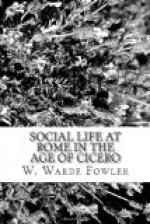[Footnote 9: Horace Od. i. 2. After a bad flood in A.D. 15 proposals were made for diverting a part of the water coming down the Tiber into the Arnus, but this met with fatal opposition from the superstition of the country people (Tacitus, Ann. i. 79). Nissen, Italische Landeskunde, i. p. 324, has collected the records of these floods.]
[Footnote 10: See Nissen, i. p. 407. But it seems likely that the Tiber valley was less malarious then than now (see Nissen’s chapter on malaria in Italy, p. 410 foll.). In an interesting paper on Malaria and History, by Mr. W.H.S. Jones (Liverpool University Press), which reached me after this chapter was written, the author is inclined to attribute the ethical and physical degeneracy of the Romans of the Empire partly to this cause.]
[Footnote 11: Livy v. 54.]
[Footnote 12: Horace, Epode 16.]
[Footnote 13: Reden und Aufsaetze, p. 173 foll.]
[Footnote 14: Ib. p. 175.]
[Footnote 15: De Rep. ii. 5 and 6.]
[Footnote 16: Beloch, Die Bewoelkerung der griechisch-roemischen Welt, cap. 9, approaching the problem by three several methods, puts it in the first century A.D. at 800,000, including slaves. In Cicero’s time it was, no doubt, considerably less; but we know that in his last years 320,000 free persons were receiving doles of corn, apart from slaves and the well-to-do.]
[Footnote 17: Huelsen-Jordan, Roem. Topographie, vol. i. part iii. pp. 627, 638.]
[Footnote 18: Ib. 643; Cic. ad Att. xv. 15. Here, after the death of his daughter Tullia, Cicero wished to buy land on which to erect a fanum to her (Cic. ad Att. xii. 19). Here also were the horti Caesaris.]
[Footnote 19: Livy xxxv. 40.]
[Footnote 20: Huelsen-Jordan, op. cit. p. 143 note.]
[Footnote 21: See below, p. 302. Dionysius of Halicarnassus (iii. 68) gives an elaborate account of it in the time of Augustus, when it had been altered and ornamented.—Huelsen-Jordan, p. 120 foll.]
[Footnote 22: Fowler, Roman Festivals, p. 199; Wissowa in Pauly-Wissowa, Real-Encyklopaedie, s.v. Diana.]
[Footnote 23: The two roads converged just before arriving at the city. The reader may be reminded that it was by the via Appia that St. Paul entered Rome (Acts xxviii.). Another useful passage for this gate is Juvenal in. 10 foll.]
[Footnote 24: It might be useful here to follow the course of the pomerium, which also went round the Palatine, as described in Tacitus, Annals xii. 24.]
[Footnote 25: Cic. de Officiis iii. 16. 66, and the story there related.]
[Footnote 26: Strictly speaking, the Oppius Mons, or southern part of the Esquiline.]
[Footnote 27: See Lanciani’s admirable chapter, “A Walk through the Sacra Via,” in his Ruins and Excavations of Ancient Rome, p. 190 foll.]




